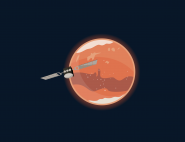Mars water vapor abundance from SPICAM IR spectrometer: Seasonal and geographic distributions
Fedorova A., Korablev O., Bertaux J.-L., Rodin A., Kiselev A., Perrier S.
Journal of Geophysical Research A: Space Physics
Summary: The near-IR channel of SPICAM experiment on Mars Express spacecraft is a 800-g acousto-optic tunable filter (AOTF)-based spectrometer operating in the spectral range of 1-1.7 µm with resolving power of 2000. It was put aboard as an auxiliary channel dedicated to nadir H2O measurements in the 1.37-µm spectral band. This primary scientific goal of the experiment is achieved though successful water vapor retrievals, resulting in spatial and seasonal distributions of H2O. We present the results of H2O retrieval from January 2004 (Ls = 330°) to December 2005 (Ls = 340°), covering the entire Martian year. The seasonal trend of water vapor obtained by SPICAM IR is consistent with TES results and reveals disagreement with MAWD results related to south pole maximum. The main feature of SPICAM measurements is globally smaller water vapor abundance for all seasons and locations including polar regions, as compared to other data. The maximum abundance is 50-55 precipitable microns at the north pole and 13-16 precipitable microns (pr µm) at the south pole. The northern tropical maximum amounts to 12-15 pr wn. Possible reasons for the disagreements are discussed. © 2006 by the American Geophysical Union.


